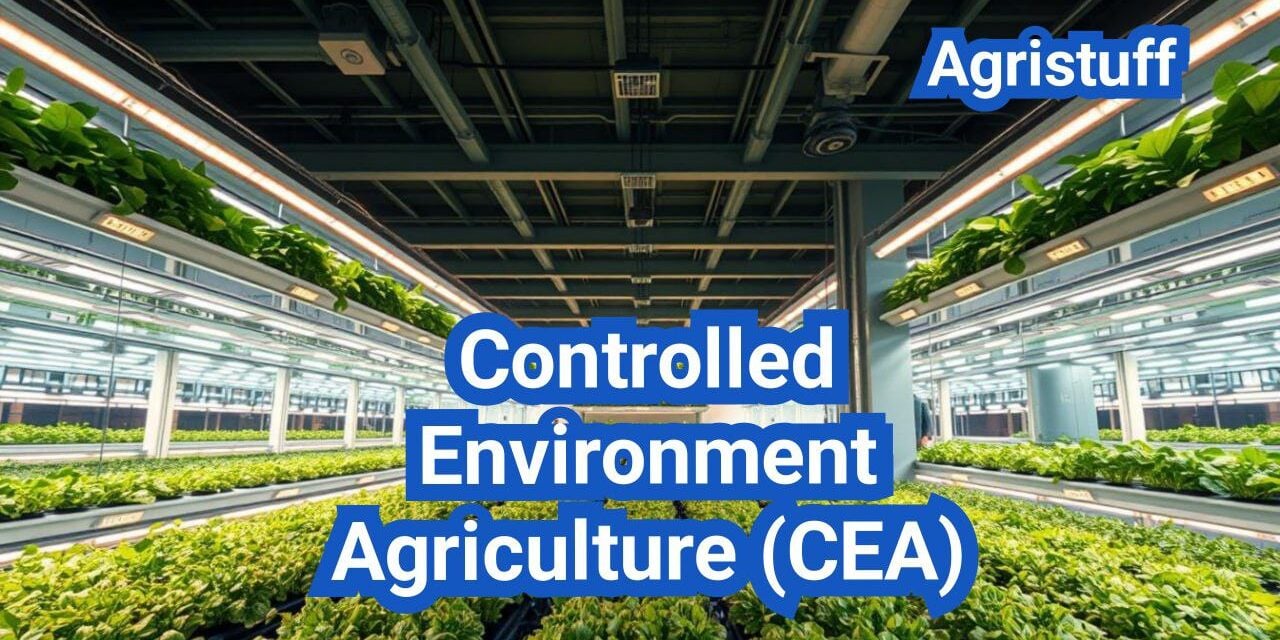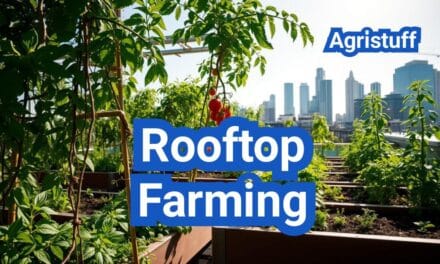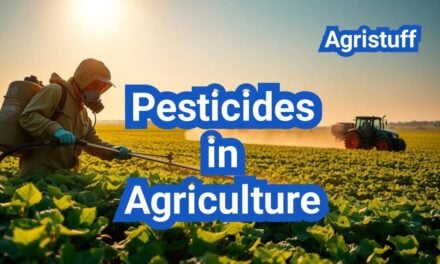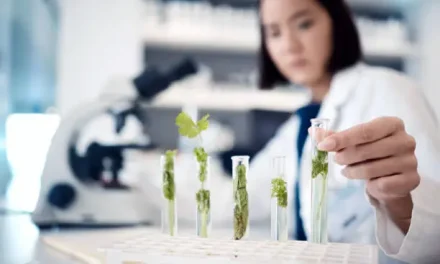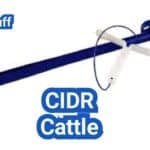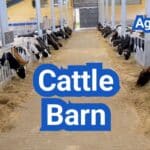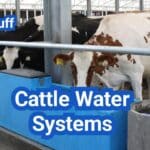Indoor agriculture is revolutionizing the way we grow crops, and Controlled Environment Agriculture (CEA) is at the forefront of this change. CEA involves growing plants in a controlled environment, such as a greenhouse or indoor facility, where conditions like temperature, humidity, and light are optimized for maximum yield.
The global CEA market is expected to grow significantly, driven by the increasing demand for fresh produce and sustainable farming practices. Vertical farming and hydroponics are key components of CEA, allowing for efficient use of space and resources.
Key Takeaways
- CEA optimizes crop growth through precise climate control.
- Advanced sensors play a crucial role in monitoring and adjusting CEA systems.
- The CEA market is growing due to increasing demand for sustainable farming practices.
- Vertical farming and hydroponics are key technologies in CEA.
- CEA allows for efficient use of resources and maximized yields.
What is Controlled Environment Agriculture (CEA)?
Controlled Environment Agriculture (CEA) represents a revolutionary approach to farming by utilizing advanced technology to optimize crop growth in controlled environments. This method allows for the precise control of environmental factors such as temperature, humidity, and light, creating ideal conditions for crop growth.
Definition and Core Principles
At its core, CEA involves growing crops in controlled environments, such as greenhouses or indoor facilities, using advanced technologies like hydroponics and LED lighting. The core principles of CEA include optimizing growing conditions, minimizing environmental impact, and maximizing crop yields. By controlling factors such as temperature, humidity, and light, farmers can create optimal growing conditions for their crops.
Key components of CEA include:
- Climate control systems
- Advanced irrigation systems
- Precision agriculture technologies
- Monitoring and automation systems
Evolution of CEA Technology
CEA technology has evolved significantly over the years, from simple greenhouses to sophisticated indoor farming facilities. Advances in LED lighting, hydroponics, and automation have enabled farmers to control every aspect of the growing environment. The integration of data analytics and machine learning has further optimized crop growth and reduced waste.
The evolution of CEA technology has been driven by the need for sustainable and efficient farming practices. As the global population continues to grow, the demand for food is increasing, and CEA offers a promising solution to meet this demand while minimizing environmental impact.
Benefits Over Traditional Farming
CEA offers several benefits over traditional farming methods, including increased crop yields, reduced water usage, and minimized environmental impact. By controlling the growing environment, farmers can reduce the risk of crop failure due to weather events or pests. Additionally, CEA enables farmers to produce crops year-round, regardless of the season or weather conditions.
The benefits of CEA include:
- Increased crop yields
- Reduced water usage
- Minimized environmental impact
- Improved crop quality
- Year-round production
Designing Your CEA System: Structure Options

The choice of structure for a CEA system design is pivotal, influencing not only the initial investment but also long-term operational costs and environmental sustainability. Different structures offer varying degrees of control over environmental factors, which is crucial for optimizing crop growth and reducing energy consumption.
Greenhouse Systems
Greenhouse farming systems are one of the most traditional and widely used structures in CEA. They provide a controlled environment that can be optimized for various crops. Greenhouses can be made from a variety of materials, including glass and plastic films, each with its own advantages in terms of light transmission, insulation, and cost.
The design of a greenhouse system can significantly impact its efficiency. Factors such as orientation, ventilation, and shading systems play crucial roles in maintaining optimal growing conditions. Modern greenhouses often incorporate advanced technologies like automated climate control and precision irrigation systems.
Vertical Farming Facilities
Vertical farming represents a more recent innovation in CEA, where crops are grown in vertically stacked layers. This approach maximizes space usage, making it particularly suitable for urban areas or regions with limited arable land.
Vertical farming facilities often rely on LED lighting due to the limited natural light penetration to lower layers. The controlled environment allows for precise control over temperature, humidity, and CO2 levels, optimizing crop growth. However, the high initial investment in infrastructure and energy costs for lighting are significant considerations.
Indoor Plant Factories
Indoor plant factories are fully controlled environments where crops are grown indoors without any reliance on natural light. These facilities use LED lighting to provide the necessary spectrum and intensity for plant growth.
Indoor plant factories offer the highest level of control over environmental conditions, allowing for year-round production of crops. They are particularly useful for leafy greens and herbs. However, the energy consumption for lighting and climate control can be substantial, impacting operational costs.
Container Farming Solutions
Container farming involves using shipping containers as the structure for growing crops. These containers are modified to provide a controlled environment, often using hydroponic or aeroponic systems.
Container farming solutions are highly modular and can be easily transported and deployed in various locations. They offer a quick entry into CEA with relatively low initial investment compared to greenhouses or vertical farms. However, scalability can be a challenge, and energy costs need to be carefully managed.
Managing Environmental Factors in CEA
In Controlled Environment Agriculture, managing environmental factors such as light, temperature, and CO₂ levels is key to optimizing crop growth. Effective environmental control allows growers to create ideal conditions for their crops, leading to improved yields and reduced energy consumption.
Light Management Strategies
Light is one of the most critical factors in CEA. Different crops have varying light requirements, and managing light intensity, spectrum, and duration is essential. LED grow lights are becoming increasingly popular due to their energy efficiency and ability to provide specific spectra tailored to different crops.
Key considerations for light management include:
- Intensity: Ensuring sufficient light intensity for photosynthesis.
- Spectrum: Providing the appropriate light spectrum for the specific crop.
- Duration: Managing photoperiod to influence plant growth and flowering.
Temperature and Humidity Control
Temperature and humidity are closely linked factors that significantly impact plant growth and health. Maintaining optimal temperature ranges and humidity levels is crucial for preventing stress and promoting healthy development.
| Crop | Optimal Temperature (°F) | Optimal Humidity (%) |
|---|---|---|
| Leafy Greens | 65-75 | 40-60 |
| Tomatoes | 70-80 | 50-70 |
| Cucumbers | 75-85 | 60-80 |
Optimizing Vapor Pressure Deficit (VPD)
Vapor Pressure Deficit is the difference between the amount of moisture in the air and the amount of moisture the air can hold. Optimizing VPD is crucial for managing transpiration rates and preventing water stress in plants.
Strategies for optimizing VPD include:
- Monitoring temperature and humidity levels.
- Adjusting VPD through heating, cooling, or humidification.
- Using VPD sensors to provide real-time data.
CO₂ Enrichment Methods
CO₂ enrichment is a technique used to enhance plant growth by increasing the concentration of CO₂ in the growing environment. This can lead to significant increases in yield and improvements in crop quality.
Common CO₂ enrichment methods include:
- CO₂ generators.
- CO₂ tanks.
- On-demand CO₂ supply systems.
Setting Up Hydroponic Growing Systems

Setting up hydroponic growing systems is a crucial step in Controlled Environment Agriculture (CEA), enabling growers to optimize crop yields. Hydroponic systems deliver nutrients directly to the roots, enhancing growth rates and reducing water consumption.
Nutrient Film Technique (NFT) Implementation
The Nutrient Film Technique (NFT) is a popular hydroponic method where crops are grown in long, narrow channels with a continuous flow of nutrient-rich solution. This technique allows for efficient water use and precise control over nutrient delivery.
To implement NFT, growers need to set up a system of channels, a pump, and a reservoir. The channels are typically made of PVC or other durable materials, and the pump is used to circulate the nutrient solution.
Deep Water Culture (DWC) Systems
Deep Water Culture (DWC) is another effective hydroponic method where plants are suspended above a reservoir of nutrient-rich water. The roots grow down into the water, absorbing the necessary nutrients.
DWC systems are relatively simple to set up and maintain, requiring a reservoir, an air stone for oxygenation, and a pump. This method is particularly suitable for leafy greens and other crops that thrive in moist environments.
Drip Irrigation Setup
Drip irrigation is a hydroponic technique that delivers nutrients directly to the base of each plant through a network of tubes and drippers. This method is highly efficient, reducing waste and ensuring that each plant receives the necessary nutrients.
To set up a drip irrigation system, growers need to install a main line, sub-main lines, and drippers. The system should be designed to ensure uniform distribution of nutrients across all plants.
Ebb and Flow System Design
The Ebb and Flow system, also known as flood and drain, is a hydroponic method that involves periodically flooding the growing area with nutrient-rich solution and then draining it. This cycle provides plants with the necessary nutrients while also oxygenating the roots.
To design an Ebb and Flow system, growers need to construct a floodable tray, a reservoir, and a pump. The system should be configured to flood and drain at regular intervals, typically using a timer to control the pump.
Implementing Advanced CEA Growing Techniques
The use of advanced growing techniques in CEA is transforming the way crops are cultivated, making it more sustainable and efficient. These innovative methods allow for greater control over the growing environment, resulting in improved crop yields and reduced resource consumption.
Aeroponic System Installation
Aeroponic systems represent a cutting-edge growing technique in CEA, where roots are suspended in the air and misted with nutrient-rich solutions. This method promotes healthy root development and enhances nutrient uptake.
Key benefits of aeroponic systems include:
- Increased water efficiency
- Improved root oxygenation
- Enhanced crop growth rates
To implement an aeroponic system effectively, it’s crucial to consider factors such as misting frequency, nutrient solution composition, and system maintenance.
Aquaponics Integration
Aquaponics combines CEA with aquaculture, creating a symbiotic system where fish or other aquatic animals are raised alongside crops. This integrated approach recycles water and nutrients, minimizing waste and enhancing overall system productivity.
| Component | Function | Benefits |
|---|---|---|
| Fish or Aquatic Animals | Produce waste that is converted into nutrients | Diverse revenue streams, protein production |
| Biofilter | Converts ammonia into nitrate | Water quality management |
| Crops | Absorb nutrients from water | Water purification, crop production |
Aquaponics requires careful balancing of the ecosystem to ensure the health of both plants and aquatic animals.
Substrate-Based Growing Methods
Substrate-based growing involves using materials like coconut coir, peat moss, or rockwool to support plant growth. This method offers flexibility and can be adapted to various CEA systems.
Advantages of substrate-based growing include:
- Improved root zone management
- Enhanced crop stability
- Flexibility in system design
Selecting the appropriate substrate is critical for optimizing crop performance and system efficiency.
Selecting and Installing Horticultural Lighting
Horticultural lighting is a critical component in Controlled Environment Agriculture (CEA) systems, directly influencing crop yield and quality. The right lighting can significantly enhance plant growth, making it essential to select and install the appropriate horticultural lighting for your CEA setup.
LED Lighting Systems Comparison
LED lighting has become a popular choice for CEA due to its energy efficiency and customizable spectrum. When comparing LED lighting systems, several factors should be considered:
- Energy Efficiency: LEDs are known for their low energy consumption, but efficiency can vary between models.
- Spectrum Customization: The ability to adjust the light spectrum to suit different crops is a significant advantage.
- Durability: LEDs are long-lasting, but their lifespan can depend on the quality of the product.
A comparison of different LED lighting systems is provided in the table below:
| LED System | Energy Efficiency (μmol/J) | Spectrum Customization | Lifespan (hours) |
|---|---|---|---|
| System A | 2.5 | Yes | 50,000 |
| System B | 2.8 | No | 40,000 |
| System C | 3.0 | Yes | 60,000 |
Spectrum Management for Different Crops
Different crops have varying lighting requirements. Spectrum management involves adjusting the light spectrum to meet the specific needs of the crops being grown.
For example, leafy greens may require a different spectrum than fruiting plants. Understanding these requirements is crucial for optimizing growth.
Light Placement and Coverage Planning
Proper light placement and coverage are critical for ensuring that all plants receive adequate light. Factors to consider include the height of the lights above the canopy, the density of the plantings, and the layout of the growing area.
Effective light placement can help prevent shading and ensure uniform growth across the crop.
By carefully selecting and installing horticultural lighting, CEA operators can significantly improve crop yields and quality, making their operations more productive and profitable.
Deploying Sensor Technologies and Automation

Deploying advanced sensor technologies and automation in CEA is key to optimizing crop growth and reducing labor costs. By integrating these technologies, growers can create a highly controlled environment that maximizes yield and quality.
Essential Environmental Monitoring Systems
Environmental monitoring systems are crucial for maintaining optimal conditions within CEA facilities. These systems typically include sensors for monitoring temperature, humidity, and CO2 levels. Advanced sensors can provide real-time data, enabling growers to make informed decisions quickly. For instance, monitoring temperature fluctuations can help prevent stress to crops, while CO2 monitoring ensures optimal levels for photosynthesis.
Nutrient and pH Monitoring Solutions
Nutrient and pH monitoring are vital for hydroponic and other soilless growing systems used in CEA. pH sensors measure the acidity or alkalinity of the nutrient solution, while nutrient sensors monitor the levels of essential nutrients. This information allows growers to adjust the nutrient solution in real-time, ensuring that crops receive exactly what they need.
Integrated Control System Implementation
An integrated control system brings together data from various sensors and automates control over environmental factors and nutrient delivery. This centralized control enables growers to manage their CEA facility more efficiently, responding to changes in real-time and minimizing manual intervention.
Data Collection and Analysis Tools
Data collection and analysis are critical for optimizing CEA operations. By analyzing data from environmental and nutrient monitoring systems, growers can identify trends and patterns that inform future decisions. Advanced data analytics can predict potential issues before they become critical, allowing for proactive management.
By leveraging these technologies, CEA operators can significantly enhance the productivity and sustainability of their operations, ultimately leading to higher quality crops and reduced operational costs.
Optimizing Energy Efficiency in CEA

To minimize operational costs and environmental impact, CEA facilities must prioritize energy efficiency. This involves implementing advanced technologies and strategies that reduce energy consumption while maintaining optimal growing conditions.
HVAC System Selection and Setup
Heating, Ventilation, and Air Conditioning (HVAC) systems play a critical role in maintaining the optimal climate within CEA facilities. Efficient HVAC systems can significantly reduce energy consumption. When selecting an HVAC system, factors such as the size of the facility, climate, and specific crop requirements must be considered.
The setup of the HVAC system is equally important. Proper installation and regular maintenance are crucial to ensure that the system operates at peak efficiency. This includes regular filter cleaning and ensuring that all components are functioning correctly.
Renewable Energy Integration Options
Integrating renewable energy sources into CEA operations can significantly reduce reliance on non-renewable energy and lower operational costs. Solar panels, wind turbines, and geothermal systems are among the renewable energy options available.
When considering renewable energy integration, it’s essential to assess the feasibility of different energy sources based on the facility’s location and energy requirements. For example, solar panels may be more suitable for facilities located in areas with high solar irradiance.
Thermal Management Strategies
Effective thermal management is crucial for maintaining optimal temperatures within CEA facilities. This can be achieved through various strategies, including the use of thermal insulation, shading systems, and advanced climate control systems.
Thermal mass can also play a role in thermal management by absorbing and releasing heat as needed, helping to stabilize temperatures within the facility.
By implementing these strategies, CEA facilities can significantly improve their energy efficiency, reducing both operational costs and environmental impact.
Implementing Water Conservation Systems

Implementing effective water conservation systems is essential for reducing waste and optimizing resource use in CEA facilities. Water conservation is critical in CEA due to its significant impact on both the environmental sustainability and the economic viability of farming operations.
Efficient Recirculation System Design
A well-designed recirculation system is crucial for minimizing water waste in CEA. This involves collecting, treating, and reusing water that would otherwise be discharged. Recirculation systems can significantly reduce the overall water consumption of a CEA facility.
The design of a recirculation system should consider factors such as the type of crops being grown, the size of the operation, and the local water quality regulations. For instance, a closed-loop system that continuously recirculates water can be highly effective in conserving water.
Advanced Water Treatment and Filtration Methods
Effective water treatment and filtration are vital components of a water conservation strategy in CEA. Various methods can be employed, including physical, chemical, and biological treatments, to remove contaminants and pathogens from the water.
- Physical treatments involve processes like sedimentation and filtration to remove particulate matter.
- Chemical treatments use disinfectants or other chemicals to kill pathogens.
- Biological treatments utilize living organisms or their byproducts to purify the water.
The choice of treatment method depends on the specific requirements of the CEA operation and the quality of the water being used.
Water Usage Monitoring and Reduction Strategies
Monitoring water usage is essential for identifying areas of inefficiency and implementing reduction strategies. This can involve installing water meters and monitoring systems to track water consumption in real-time.
| Strategy | Description | Potential Water Savings |
|---|---|---|
| Recirculation Systems | Collecting, treating, and reusing water | Up to 90% |
| Drip Irrigation | Delivering water directly to the roots | Up to 50% |
| Water-efficient Crops | Selecting crops with low water requirements | Up to 30% |
By implementing these strategies, CEA operators can significantly reduce their water usage, contributing to a more sustainable and environmentally friendly farming practice.
Selecting and Optimizing Crops for CEA

The success of Controlled Environment Agriculture (CEA) largely depends on selecting the right crops and optimizing their growth cycles. This critical aspect of CEA directly impacts the profitability and sustainability of the operation.
High-Value Crop Selection Criteria | Controlled Environment Agriculture (CEA)
Selecting high-value crops is essential for maximizing returns on investment in CEA. When choosing crops, consider factors such as market demand, growth rate, and profit margins. Crops like leafy greens, herbs, and certain fruits are often in high demand and can command premium prices.
To make informed decisions, growers should conduct thorough market research and analyze consumer trends. This involves understanding the local and global market dynamics to identify opportunities for high-value crops.
- Assess the growth cycle and yield potential of the crop.
- Evaluate the crop’s resistance to diseases and pests.
- Consider the crop’s adaptability to the CEA environment.
Growth Cycle Planning and Scheduling | Controlled Environment Agriculture (CEA)
Effective growth cycle planning and scheduling are crucial for maintaining a continuous supply of crops and maximizing the use of CEA facilities. This involves strategic planning of planting and harvesting schedules to ensure a consistent yield.
Growers should utilize data analytics and forecasting tools to predict market demand and adjust their planting schedules accordingly. This helps in avoiding overproduction and reducing waste.
- Develop a detailed planting schedule based on historical data and market trends.
- Implement a crop rotation plan to maintain soil health and reduce disease risk.
- Monitor and adjust the growth cycle based on real-time environmental data.
Techniques for Maximizing Yield and Quality | Controlled Environment Agriculture (CEA)
To maximize yield and quality, CEA growers can employ various techniques. One effective method is precision agriculture, which involves using advanced technology to monitor and control growing conditions.
Another technique is vertical farming, which allows for the maximization of space by growing crops in vertically stacked layers. This method can significantly increase yield per square foot.
| Technique | Description | Benefits |
|---|---|---|
| Precision Agriculture | Using advanced technology to monitor and control growing conditions. | Increased yield, improved quality, reduced waste. |
| Vertical Farming | Growing crops in vertically stacked layers. | Maximized space, increased yield per square foot. |
| Hydroponics | Growing plants in a nutrient-rich solution rather than soil. | Improved nutrient control, water conservation. |
By carefully selecting and optimizing crops, CEA operators can significantly enhance their operation’s profitability and sustainability. Implementing these strategies requires a thorough understanding of market dynamics, growth cycles, and advanced growing techniques.
Navigating the Controlled Environment Agriculture Market
As the world shifts towards sustainable agriculture, the CEA market is poised for significant expansion. The increasing demand for fresh produce and the need for efficient farming practices are driving this growth.
Market Size and Growth Opportunities | Controlled Environment Agriculture (CEA)
The CEA market is experiencing rapid growth, with projections indicating a substantial increase in the coming years. This growth is driven by advancements in technology, including improved hydroponic systems and LED lighting. The market size is expected to expand as more investors and farmers adopt CEA practices.
Key growth opportunities include the increasing adoption of vertical farming, the integration of AI and IoT in farming practices, and the rising demand for organic produce. These opportunities are not only expanding the market but also driving innovation within the sector.
Leading CEA Companies and Technologies | Controlled Environment Agriculture (CEA)
Several leading companies are at the forefront of the CEA industry, driving innovation and adoption. Companies like Plants Do Grow and Infarm are pioneering new technologies and methods in vertical farming and hydroponics.
The use of advanced technologies such as LED lighting and climate control systems is becoming more prevalent. These technologies enable farmers to optimize growing conditions, leading to higher yields and better quality produce.
Distribution Channels and Market Access | Controlled Environment Agriculture (CEA)
Effective distribution channels are crucial for the success of CEA operations. Farmers and producers are exploring various channels, including direct-to-consumer sales, partnerships with local grocery stores, and online marketplaces.
Market access is also being enhanced through the development of new business models, such as subscription-based services and community-supported agriculture programs. These models provide consumers with fresh produce while offering farmers a stable revenue stream.
Forming Strategic Partnerships | Controlled Environment Agriculture (CEA)
Forming strategic partnerships is essential for companies looking to expand their presence in the CEA market. Partnerships can provide access to new technologies, markets, and resources, enabling companies to stay competitive.
Collaborations between technology providers, farmers, and retailers are becoming increasingly common. These partnerships are driving innovation and helping to address some of the challenges faced by the CEA industry, such as energy efficiency and cost reduction.
Obtaining Certification and Compliance

Certification is a critical step for CEA operators to ensure their produce meets regulatory standards and consumer expectations. As the CEA industry continues to expand, understanding and obtaining necessary certifications is vital for market access and compliance.
Food Safety Certification Process | Controlled Environment Agriculture (CEA)
Food safety certification is paramount in CEA operations. It involves a thorough audit of the production process to ensure compliance with food safety regulations. The process typically includes:
- Implementation of Good Agricultural Practices (GAPs)
- Regular facility inspections
- Training for staff on food safety protocols
- Documentation and record-keeping of safety procedures
According to the FDA, “Food safety is a critical component of the agricultural industry, and certification is key to ensuring consumer trust.”
Organic Certification Requirements | Controlled Environment Agriculture (CEA)
For CEA operators looking to market their produce as organic, obtaining organic certification is essential. This involves:
- Adhering to the USDA’s National Organic Program (NOP) standards
- Maintaining detailed records of production and handling practices
- Undergoing annual inspections by a USDA-accredited certifying agent
The process ensures that organic produce meets strict guidelines, enhancing consumer confidence.
Sustainability Certification Options | Controlled Environment Agriculture (CEA)
Sustainability certifications are increasingly important in the CEA industry, as they demonstrate a commitment to environmental stewardship and social responsibility. Options include:
- LEED (Leadership in Energy and Environmental Design) certification for facilities
- Certifications from organizations like the Sustainable Agriculture Coalition
Compliance Documentation Systems | Controlled Environment Agriculture (CEA)
Effective compliance documentation is crucial for CEA operators to maintain certification and ensure regulatory compliance. This involves implementing robust record-keeping systems that track:
- Production practices
- Input materials
- Sales and distribution records
“Accurate and detailed documentation is the backbone of compliance in CEA operations, enabling operators to demonstrate adherence to regulatory standards.”
Calculating and Maximizing CEA Return on Investment

To ensure financial sustainability, CEA operators must carefully calculate and maximize their return on investment. This involves a comprehensive analysis of various financial components.
Capital Expenditure Planning | Controlled Environment Agriculture (CEA)
Initial investments in CEA infrastructure, such as greenhouses or indoor farming facilities, are significant. Capital expenditure planning involves budgeting for these initial costs, including land acquisition, facility construction, and equipment installation.
A detailed breakdown of initial investments helps in understanding the total capital required and potential funding options.
Operational Cost Tracking | Controlled Environment Agriculture (CEA)
Ongoing operational costs in CEA include energy consumption, water usage, labor, and inputs like seeds and nutrients. Tracking these costs is essential for maintaining profitability.
- Energy consumption monitoring
- Water usage optimization
- Labor cost management
- Input cost control
Revenue Projection Methods | Controlled Environment Agriculture (CEA)
Accurate revenue projection is critical for ROI calculation. This involves analyzing market demand, pricing strategies, and sales channels to estimate future revenue.
| Revenue Stream | Projected Annual Revenue | Growth Rate |
|---|---|---|
| Direct Sales | $200,000 | 10% |
| Wholesale | $150,000 | 8% |
| Online Sales | $50,000 | 15% |
Risk Assessment and Mitigation Strategies
CEA operations are subject to various risks, including market fluctuations, crop diseases, and technological failures. Conducting a thorough risk assessment and implementing mitigation strategies are crucial for protecting investments.
Strategies may include diversifying crops, investing in insurance, and implementing robust disease management protocols.
Troubleshooting Common CEA Challenges
Despite its many advantages, CEA is not immune to challenges, including disease outbreaks and technical failures. Effective troubleshooting is crucial for maintaining the health and productivity of CEA systems.
Disease and Pest Management Protocols | Controlled Environment Agriculture (CEA)
Disease and pest management are critical components of CEA operations. Implementing strict biosecurity measures, such as quarantine protocols and sanitation practices, can significantly reduce the risk of disease outbreaks.
Regular monitoring for pests and diseases is essential. This can be achieved through regular crop inspections and the use of monitoring tools like sticky traps.
“The key to effective disease management is early detection and swift action.” – Dr. Jane Smith, CEA Expert
Technical System Failure Resolution | Controlled Environment Agriculture (CEA)
Technical failures can have a significant impact on CEA operations, leading to crop losses and reduced yields. Implementing redundant systems and having a comprehensive maintenance schedule can help minimize the risk of technical failures.
In the event of a technical failure, having a trained response team in place can help resolve issues quickly and minimize downtime.
Labor and Expertise Development | Controlled Environment Agriculture (CEA)
CEA operations require specialized knowledge and skills. Providing ongoing training and development opportunities for staff can help ensure that they have the necessary expertise to manage CEA systems effectively.
Attracting and retaining skilled labor can be challenging. Offering competitive salaries and benefits and creating a positive work environment can help mitigate this challenge.
Scaling Operations Successfully | Controlled Environment Agriculture (CEA)
Scaling CEA operations requires careful planning and execution. Developing a strategic growth plan and investing in scalable technologies can help ensure that operations can be expanded efficiently.
It’s also important to monitor and adjust operations as they scale to ensure that the system remains optimized and productive.
The Future of Controlled Environment Agriculture
The future of CEA is closely tied to its potential to contribute to sustainable agriculture and food security. As the global population continues to grow, the need for innovative and efficient farming methods becomes increasingly important. CEA, including indoor farming and vertical farming, offers a promising solution by providing a controlled environment that optimizes crop growth and reduces environmental impact.
By leveraging advanced technologies such as hydroponics, aeroponics, and LED lighting, CEA facilities can significantly increase crop yields while minimizing water usage and land requirements. This approach to farming not only enhances food security but also supports sustainable agriculture practices, making it an attractive option for the future.
As the CEA industry continues to evolve, we can expect to see further innovations in areas such as energy efficiency, automation, and crop optimization. With its potential to transform the way we produce food, CEA is poised to play a critical role in shaping the future of sustainable agriculture.
FAQ
What is Controlled Environment Agriculture (CEA)?
Controlled Environment Agriculture (CEA) is a type of agricultural practice where the growing environment is controlled to optimize crop growth, yield, and quality. This includes indoor or vertical farming, greenhouses, and other controlled environment systems.
What are the benefits of CEA over traditional farming methods?
CEA offers several benefits, including increased crop yields, reduced water consumption, improved crop quality, and reduced environmental impact. It also allows for year-round production, regardless of weather conditions, and can be located in urban areas, reducing transportation costs.
What are the different structure options available for designing a CEA system?
The different structure options available for designing a CEA system include greenhouse systems, vertical farming facilities, indoor plant factories, and container farming solutions. Each has its advantages and limitations, and the choice depends on factors such as climate, crop selection, and budget.
How do I manage environmental factors in CEA?
Managing environmental factors in CEA involves controlling light, temperature, humidity, CO₂ levels, and other factors to create optimal growing conditions. This can be achieved through the use of advanced systems and sensors, such as LED lighting, climate control systems, and CO₂ enrichment methods.
What are the different hydroponic growing systems available for CEA?
The different hydroponic growing systems available for CEA include Nutrient Film Technique (NFT), Deep Water Culture (DWC), drip irrigation, and ebb and flow systems. Each has its advantages and challenges, and the choice depends on factors such as crop selection, water quality, and budget.
What is the role of horticultural lighting in CEA?
Horticultural lighting plays a crucial role in CEA, as it provides the necessary light for crop growth. LED lighting systems are commonly used, and spectrum management is critical to optimize crop growth and yield.
How do I deploy sensor technologies and automation in CEA?
Deploying sensor technologies and automation in CEA involves using environmental monitoring systems, nutrient and pH monitoring solutions, and integrated control systems to optimize crop growth and reduce labor costs. Data collection and analysis tools are also essential for making informed decisions.
How can I optimize energy efficiency in CEA?
Optimizing energy efficiency in CEA involves selecting and setting up energy-efficient HVAC systems, integrating renewable energy sources, and implementing thermal management strategies to reduce energy consumption and costs.
What are the strategies for implementing water conservation systems in CEA?
Strategies for implementing water conservation systems in CEA include designing recirculation systems, using water treatment and filtration methods, and monitoring and reducing water usage to minimize waste.
How do I select and optimize crops for CEA?
Selecting and optimizing crops for CEA involves choosing high-value crops, planning and scheduling growth cycles, and using techniques to maximize yield and quality. This requires careful consideration of factors such as market demand, climate, and crop characteristics.
What are the certification and compliance requirements for CEA?
Certification and compliance requirements for CEA include food safety certification, organic certification, sustainability certification, and compliance documentation systems to ensure regulatory compliance and market access.
How do I calculate and maximize ROI in CEA?
Calculating and maximizing ROI in CEA involves planning capital expenditures, tracking operational costs, projecting revenue, and assessing and mitigating risks to ensure financial viability.
What are the common challenges in CEA, and how can I troubleshoot them?
Common challenges in CEA include disease and pest management, technical system failures, labor and expertise development, and scaling operations. Troubleshooting these challenges requires implementing protocols, developing expertise, and using strategies to mitigate risks and ensure long-term viability.
What is the future of Controlled Environment Agriculture?
The future of Controlled Environment Agriculture is promising, with potential impacts on sustainable agriculture, food security, and the environment. Opportunities and challenges lie ahead, including advancements in technology, market growth, and regulatory developments.
Conclusion of: Controlled Environment Agriculture (CEA)
Why controlled environment agriculture matters now
Controlled environment agriculture gives U.S. growers resilient production, tighter specs, and year-round supply by engineering light, temperature, humidity, CO₂, airflow, and fertigation instead of leaving outcomes to weather. As climate volatility, water constraints, and buyer requirements rise, controlled environment agriculture helps maintain schedules and margins with repeatable quality and higher turns per year, especially for leafy greens, herbs, cucumbers, and tomatoes destined for regional markets and short cold chains. USDA ERS report on U.S. CEA (2024)
What controlled environment agriculture is (and isn’t)
Controlled environment agriculture is an integrated production approach that deliberately controls growing conditions—often using hydroponics—to optimize plant growth and consistency; it includes high-tech greenhouses, vertical farms, and growth rooms, but not simply “indoor” storage or low-tech hoop houses without active control. The emphasis in controlled environment agriculture is measurable steering of canopy climate and nutrition to meet commercial specifications at predictable costs. Cornell University: About CEA
Major system types in controlled environment agriculture
Three formats dominate controlled environment agriculture today: (1) greenhouse facilities that blend sunlight with supplemental systems, (2) fully enclosed vertical farms using 100% electric light across stacked layers, and (3) modular or container units for niche locations or R&D. Hydroponics (NFT, DWC, substrate drip) is the workhorse in all three, enabling precise root-zone management and recirculation. University of Missouri Extension: Hydroponics & CEA
Structure and envelope choices for controlled environment agriculture
Envelope performance drives the physics of controlled environment agriculture: glazing U-value and transmissivity, thermal screens, air-tightness, and CO₂ retention directly shape HVAC loads and plant response. Energy curtains, double poly, and targeted sealing often deliver the fastest paybacks because they lower both heating and dehumidification requirements while stabilizing the leaf microclimate. Univ. of Wisconsin Extension: Reducing Greenhouse Energy Use
Lighting fundamentals for controlled environment agriculture
Lighting is the engine of controlled environment agriculture yield. Modern LED fixtures outperform HPS/MH on efficacy and spectrum control, allowing growers to dial photosynthetic photon flux and reduce waste heat. Spectrum tuning and dimming support crop steering (e.g., compactness, coloration) while improving kWh per kilogram—provided the rest of the environment keeps pace. HortScience: Reducing Lighting Energy in CEA
Light metrics that matter in controlled environment agriculture
For decision-making, controlled environment agriculture relies on PPFD (μmol·m⁻²·s⁻¹) at the canopy and DLI (mol·m⁻²·d⁻¹) over the day; fixture efficacy is PPE (μmol·J⁻¹). Place quantum sensors at canopy height, log PPFD by zone, and convert to DLI to guide shade and dimming. This keeps light quantity aligned with biology, season, and cultivar. Michigan State University: DLI Guide
Energy baselines in controlled environment agriculture
Power planning for controlled environment agriculture starts with realistic lighting and HVAC assumptions. U.S. analyses indicate large energy footprints for horticultural lighting, with significant savings potential as LED efficacy and controls improve. These benchmarks frame demand charges, interconnection, and rebate opportunities in each utility territory. U.S. DOE: SSL in Agriculture (2020)
Adaptive lighting and DLI control in controlled environment agriculture
Because sunlight and crop stage vary daily, controlled environment agriculture benefits from adaptive setpoints that dim supplemental LEDs to hit a target DLI rather than running at fixed output. Trials show this reduces kWh and peak load while maintaining yield and quality, especially in shoulder seasons. NYSERDA: Adaptive Lighting Controller Trial
Rebates and qualifying LEDs for controlled environment agriculture
Many utilities peg horticultural LED incentives to DesignLights Consortium criteria, so controlled environment agriculture projects should select fixtures from qualifying lists and document baseline conditions. Meeting PPE and controllability thresholds can shorten payback, particularly when paired with DLI-based dimming and curtains. DesignLights Consortium: Horticulture
HVACD and VPD control in controlled environment agriculture
Heating, ventilation, air conditioning, and dehumidification (HVACD) underpin healthy canopies in controlled environment agriculture. Target vapor pressure deficit (often ~0.8–1.2 kPa for many crops) balances transpiration, nutrient flow, and disease pressure; reaching that consistently requires coordinated heat, air movement, moisture removal, and sensible CO₂ retention. Resource Innovation Institute: HVAC Best Practices
Humidity management and disease risk in controlled environment agriculture
Dense canopies load the air with moisture, so controlled environment agriculture uses cultural tactics (plant spacing, irrigation timing) and mechanical strategies (heat-mix-vent sequences, dedicated dehumidification) to keep leaf surfaces dry enough to deter botrytis and tipburn without overshooting energy budgets. UMass Extension: Reducing Greenhouse Humidity
CO₂ monitoring and enrichment in controlled environment agriculture
CO₂ drawdown is common mid-photoperiod in tight structures, so controlled environment agriculture monitors ppm continuously and enriches during lights-on when safe and justified by light and temperature. Many C3 crops respond near 800–1,000 ppm under adequate PPFD; safety, sealing, and staff training are non-negotiable. Oklahoma State Extension: CO₂ Supplementation
Water, nutrients, and recirculation in controlled environment agriculture
Hydroponic recirculation is central to controlled environment agriculture because it preserves water and nutrients while stabilizing the root-zone. When solution monitoring and sanitation are tight, studies show dramatically lower water use versus field systems at comparable yields, improving sustainability metrics for buyers. Peer-reviewed review: Hydroponics & Sustainability (2023)
pH and EC sensors: small tools, big guardrails in controlled environment agriculture
Inline and bench pH/EC meters are the sentinels of controlled environment agriculture, catching injector drift, media salt buildup, and recipe errors before they hit the P&L. Write calibration SOPs, keep logs, and corroborate inline readings with handheld instruments weekly. e-GRO: Choosing the Right pH/EC Meter
Controls and software for controlled environment agriculture
To turn data into action, controlled environment agriculture centralizes sensors and actuators into a climate computer or SCADA layer. Good practice includes sensor siting at canopy level, shielded radiation sensors, redundancy in critical zones, alarm rationalization, and role-based access so setpoints don’t drift. Ohio State University: Greenhouse Computer Control
Cropping plans that fit controlled environment agriculture physics
Crop choice dictates the physics—and the bills—of controlled environment agriculture. Fast-turn leafy greens and herbs flourish under modest DLI and HVACD load, while vine crops like tomatoes and cucumbers demand higher light, more latent removal, and more CO₂. Align crop mix with market windows, local energy tariffs, and your team’s skill set. USDA ERS: CEA Crop Trends & Values
Modeling energy and cash flow in controlled environment agriculture
Before signing purchase orders, controlled environment agriculture teams should simulate heating energy, crop timing, supplemental lighting, and curtain strategies for their exact location and structure. A free, widely used option is the USDA-ARS Virtual Grower, which helps frame demand charges, fuel mix, and seasonal setpoints for ROI planning. USDA-ARS: Virtual Grower
Financing efficiency first in controlled environment agriculture
Efficiency upgrades shorten payback in controlled environment agriculture. Map local utility incentives, specify DLC-listed LED fixtures, add DLI-based dimming, commission thermal screens, and document baseline kWh and peak kW so rebates and measured savings are straightforward for finance and lenders. DesignLights Consortium: Horticulture Programs & QPL
Compliance and food safety for controlled environment agriculture
When selling covered produce, controlled environment agriculture operations must comply with the FDA FSMA Produce Safety Rule, including agricultural water provisions, hygiene, sanitation, and records. Build SOPs early, train often, and choose sanitizers compatible with recirculating systems and buyer audits. FDA: FSMA Produce Safety Rule
GAP/GHP certification pathways in controlled environment agriculture
Many buyers require third-party verification; controlled environment agriculture can use USDA GAP/GHP audits covering water, facility conditions, worker practices, and traceability to demonstrate due diligence. Align your internal checklist with the audit scope and keep calibration, sanitation, and recall drills on schedule. USDA AMS: GAP & GHP Audits
Day-one KPI checklist for controlled environment agriculture
Operational discipline turns controlled environment agriculture data into profit. Track weekly by zone: DLI and PPFD, VPD and leaf temperature, pH/EC (solution and substrate), dissolved oxygen (when relevant), CO₂ ppm during the photoperiod, and energy intensity (kWh per kg marketable). Trend the data and tie alarms to action. MSU: Making Sense of Light Sensors
U.S. grid realities for controlled environment agriculture
Because load is concentrated, controlled environment agriculture should model demand charges and time-of-use windows, then use curtains, irrigation timing, thermal mass, and dimming to shave peaks. National studies show large savings potential from high-efficacy LEDs and controls in horticultural settings when paired with smart operations. U.S. DOE: Energy Savings Potential
Connecting physiology to P&L in controlled environment agriculture
Profitability in controlled environment agriculture depends on translating physiology into cash flow: the right cultivar under the right DLI and VPD, with tight labor standards and low shrink, beats brute-force lighting every time. Revisit crop contracts annually as energy prices, rebate criteria, and retail demand evolve. USDA ERS: Economics of CEA Crops
A practical rollout roadmap for controlled environment agriculture
Start with buyer and crop, not gadgets. For controlled environment agriculture, run a location-specific energy model, tighten the envelope, specify LED PPE and spacing to hit DLI, size HVACD to maintain VPD with CO₂ retention, plan commissioning and SOPs, and line up rebates and audits before breaking ground. USDA-ARS: Virtual Grower (planning tool)
Final thought
Controlled environment agriculture wins when physics, biology, and business math stay glued together. The best operators don’t just buy equipment; they measure DLI, VPD, pH/EC, and kWh per kilogram weekly, tune setpoints, and keep SOPs and audits sharp so quality and throughput stay predictable across seasons and markets. Cornell CEA Resources
Sources & References
- USDA ERS — Trends, Insights, and Future Prospects for CEA
- Cornell University — What Is CEA?
- University of Missouri Extension — Hydroponics as CEA
- University of Wisconsin Extension — Reducing Greenhouse Energy Use
- HortScience — Reducing Lighting Energy Use in CEA
- Michigan State University — Light Measurements & DLI
- U.S. DOE — Energy Savings Potential of SSL in Agriculture
- NYSERDA — Adaptive Lighting Controller Trial
- Resource Innovation Institute — HVAC Best Practices for CEA
- UMass Extension — Reducing Greenhouse Humidity
- Oklahoma State Extension — CO₂ Supplementation
- PMC — Hydroponics & Sustainable Crop Production
- e-GRO — Choosing the Right pH/EC Meter
- Ohio State University — Greenhouse Computer Control
- USDA AMS — GAP & GHP Audits
- FDA — FSMA Produce Safety Rule

